The unique V4, SM-1, SS-166 or USS Argonaut was an experimental US Navy cruiser submersible, and world’s largest until the French Surcouf, or the Japanese STO class in WW2. She was the very reason the cruiser submersible was not adopted, despite two smaller vessels, V5 and 6 being built afterwards. She would remain the largest non-nuclear submarines ever built by the United States, and after being tested for many missions and modified in the interwar, found some use in WW2 as the first “spec ops submarine”, carrying Marine Commandos, notably for the raid of Makin in 1942. She was ultimately sunk by Japanese destroyers off Rabaul on 10 January 1943, earning two battle stars. #ww2 #usn #Unitesstatesnavy #submersible #ussargonaut #vclasssubmarines
Development
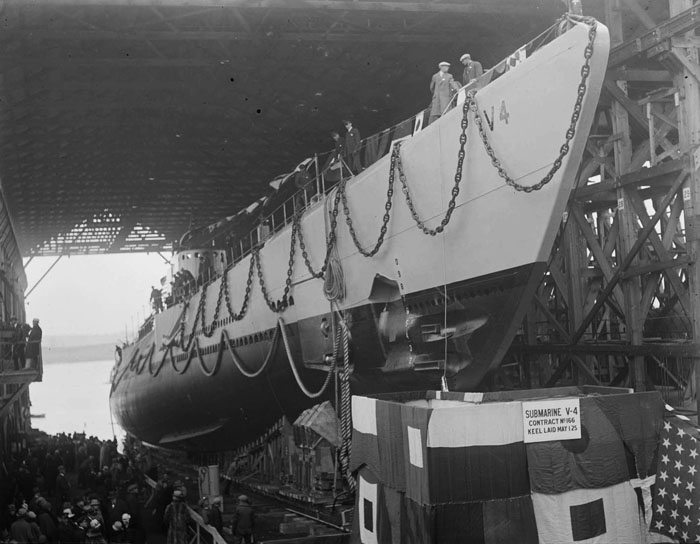
Launch of USS V4 in 1927 at Portsmouth NyD, navsrc, Boston Public Library, Leslie Jones Collection via Sean Hert & flickr.com.
The cruiser submarine concept, demonstrated during world war I by Germany gained considerable interest in all admiralties after the war as a prime example of commerce raiding asset, capable of roaming distant sea lanes and prey on shipping at will for long period of times far from bases. For the United States Navy, this venture took many aspects that would ultimately lad to “classics” such as the wartime mass-built Gato, Tench and Balao. To get there in about a decade and a half of technical evolution and tactical revisions was not smooth sailing.
We need to go back indeed to 1911 and the possibility of using submarines in fleet operations with battleships, and Holland’s proposal in 1913 of 21 knots surface boats. The three 1916 AA-1 class fleet subs proved quite disappointing due to excessive vibrations and in 1921 the “V programm” defined a new generation, voted in 1916 and built postwar. All seven “V boats” were experimental but groundbreaking. There were large fleet (oceanic) boats and three cruiser submersibles. After V1, 2 and 3 (Barracuda class) the admiralty worked on submarine cruiser concept, taking many foreign influence in account, plus asking BuC&R to generate many scheme for its consideration.
Before tackling them into a future dedicated post, here is a brief overview:
1920 BuC&R tonnes cruiser submersible proposals
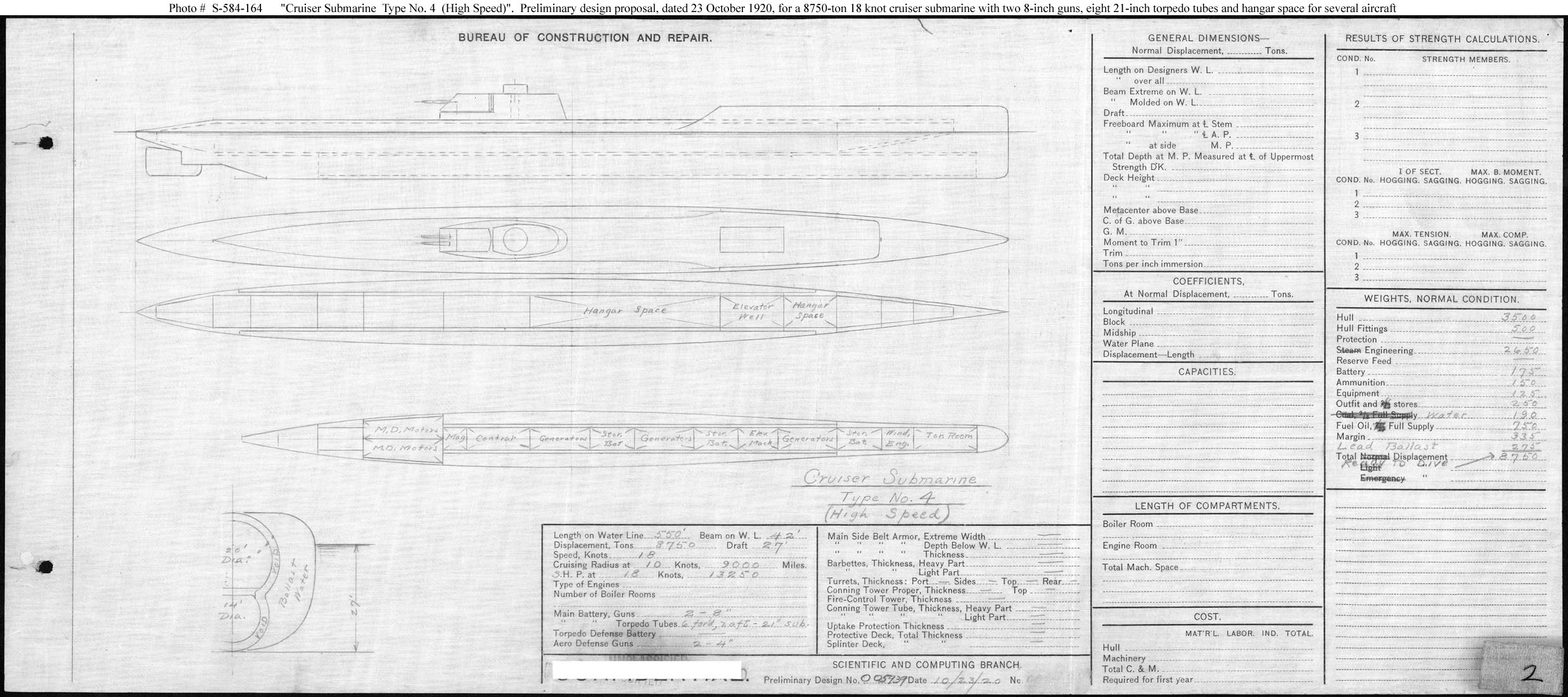
“Cruiser submarine Type N°4 (High Speed)” prelim. proposal dated 23 Oct. 1920, 8,750 tonnes 18 kts cruiser sub with two 8-in guns, eight 21-in TTs and hangar space for several aircraft. If built, she would have been a US extra-large cruiser sub. She was 550 feet long (167 meters) and 42 feet wide (13 meters), 27 ft draft (8.22 meters) so properly a monster with a narrow hull for speed, and perhaps 4+6 planes or more, wings folded inside the hangar. There was a lift and catapult on her upper deck, raised like a forecastle. The type of engines is not precised, but the blueprints estimated her range to be around 1,325 nautical miles at 18 knots and 9,000 at 10 knots. The placement of the paired 8-inches in a revolving aft conning tower “turret” was interesting.
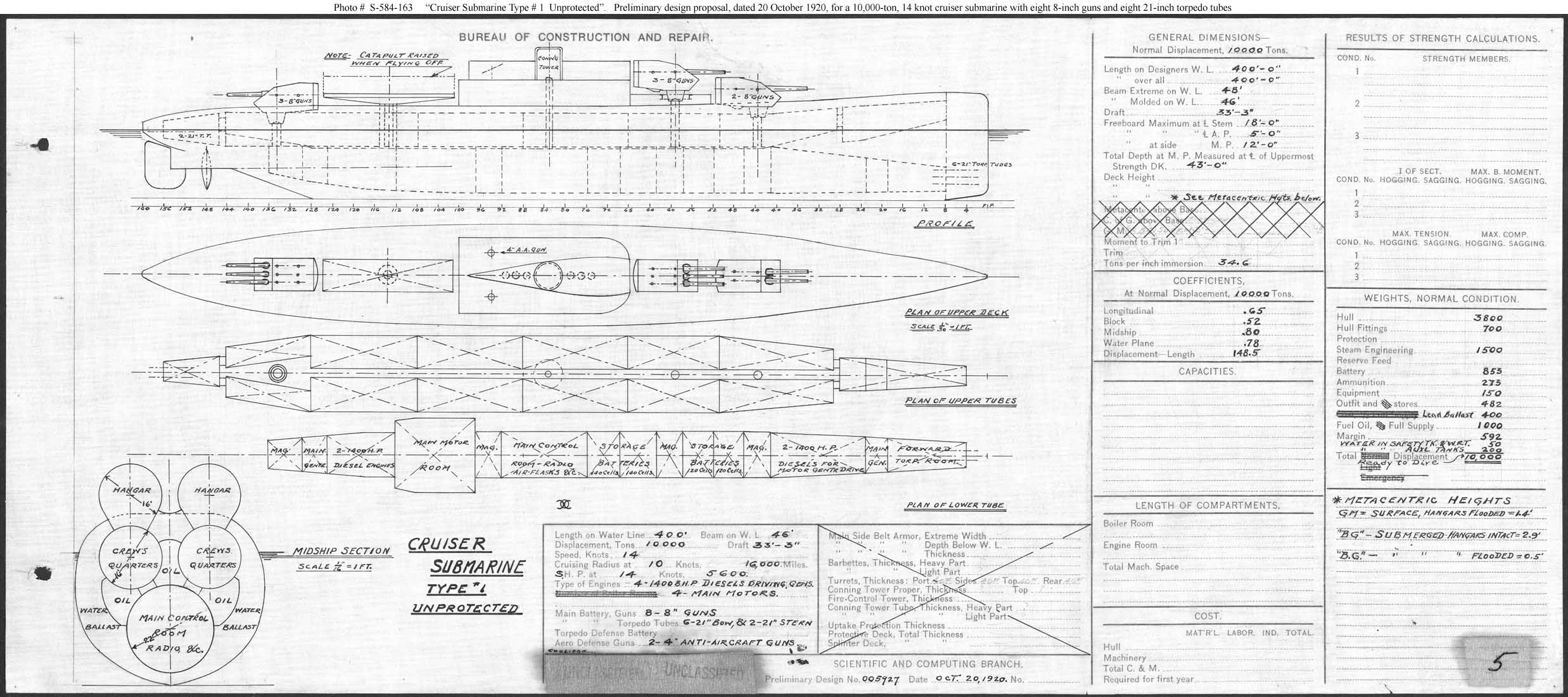
Other massive cruise subs also proposed in October 1920 included a 13,500 tons four 8-in guns inspired by the WWI Deutschland transport sub (425 x 71 feet, also with two seaplanes); and a 8-guns variant (with armour).
See also the 1920 2,380t cruiser, 1924 2,780-ton minelayer sub.
Finalization of the design
This large submanine, originally numbered V4, was unique among US types in that she was designed specifically as a minelayer. Her design evolved from the series of long-range cruiser studies begun in 1919. Characteristics of 11 April 1923 called for ability ‘to withstand pressure for operating at 300ft’ and an endurance of 90 days with a radius of not less than 6000nm at 10kts (normal fuel) and not less than 18,000nm at 10kts (maximum fuel). The relative lack of interest in speed shows in a note that “if vibration speeds are found to be absolutely unavoidable, they shall be confined between 1] and 13kts”; continuous reliable sea speed was to be 15kts on the surface. These characteristics also called for fitting to carry one observation aircraft, and for two mine tubes aft as well as four bow TT.
V-4 was indeed the first of second generation V-boats, commissioned in the late 1920s, the behemoth of its class and yet not the most outlandish considered fiven BuC&R propositions above. These submarines were exempt of any special agreement in the Washington Treaty, a big loophole that was addressed later. Her configuration like for her near-sisters V-5 and V-6, came froim thje same doctrinal change that emphasized war scenarios with Japan in the far western Pacific. The USN, which capital fleet was to be spread between the Atlantic and Pacific, looled a re-stablishing the balance, partly thanks to heavy cruisers. But the need for long-range submarine “cruisers” also called “strategic scouts”, minelayers capable of carrying recce seaplanes stressed endurance and not speed, as their main asset.
Many authors pointed out the influence of “U-cruisers” such as the Type U-139 and Type U-151 classes and that is clear in some 1920 proposals, but still, not only the latter and V-4, V-5, and V-6 were all larger. V-4 and, V-5 (Narwhal) and V-6 (Nautilus) were tailored with “German hulls” around the MAN-designed diesel engines instead of the US built Busch-Sulzer engines but they were failures. They not only failed to deliver the designed output, but they sometimes underwent crankcase explosions. V-4 in the end was given smaller MAN 1,400 hp (1,000 kW) diesels dueing her reconstruction, whereas thios of V5, V6 reached 2,350 hp (1,750 kW). Smaller, they freed space for mine storage (and were safer overalll).
A 2780 tonnes design study for a minelayer submarine, dated 20 February 1924. The true base for USS Argonaut.
The cruiser studies included much larger ships, and concentrated on surface armament (two 6-in/53 cruiser guns in Argonaut, but 7-in and even 8-in types in the larger studies), aircraft and mines. This series began in 1919 and by October 1920 some schemes showed displacements as great as 20,500 tons. This was far too great a jump from the previous figure of about 2,000, and when the Bureau of Construction and Repair resumed its studies in 1922 it returned to the original ideas of 1919 for a far simpler craft; a Design History notes that
At this time a great many of the problems pertaining to larger sizes of submarines had already been worked out on submarines V/ to V3 and many of the devices installed on American submarines as a result of war experience had been tried out on S48 to 51. In the meantime additional information had been obtained trom German sources and many plans of larger German submarines were available tor examination and study… The Bureau of Engineering had by this time practically determined to make MAN diesel engines the standard type tor propelling machinery on American submarines.
The hull was also of German origin: Initially, it was to have duplicated that of V1, but the Commander of the Control Force (Rear-Admiral M. M. Taylor) asked that the US bulbous bow type be compared to the German type, and the latter proved far superior. Argonaut was converted to a transport submarine (renumbered APS1) and with Nautilus carried Marine raiders to Makin Island on 17-19 August 1942. Range was 18,000nm at 10kts/50nm at 5kts.
Design of the class

After all considerations, V4 was agreed upon to be primarily a minelayer, instead of a classic trade raider. The concept looked far more promising. She was built at a cost of US$6,150,000, and became the first and only specialized minelayer sub built in the United States. Thius for her large size, having just four torpedo tubes forward seemed underarms for her size, yet she had two minelaying tubes aft. Still, for the yard that built her, she was a challenge, as the largest submarine ever built in the U.S, keeping this title of for 30 years.
For the first time in U.S. submarine construction, Portsmouth Navy Yard used welding when assembling section. This was pushed foward by Navy welding expert James W. Owens. Since this technoque was still experimental, he proposed to keep it only for non-critical areas: Superstructure, piping brackets and support framing. Hence her final mixed method construction as the inner and outer hulls were riveted. Welding construction on V-4 was successful and so all following subs, including V5-6 used welding at least partially until applied entirely from 1936 onwards.
Hull and general design
V4 was not far in concept from U-142, one of the most elegant “U-kreuzer” ever built. She had an edgy prow, fine lines, and two guns placed on a raised “dry” platform with extra AA gun and even a rangefinder in the conning tower. Originally she was 2158 tonns surfaced, 3350 FL submerged, for 97,50 meter long. V4 was a scaled-up version modified to carry long mine wells aft, in the outer hull. V4 as built had a surfaced displacement of 2,710 long tons (2,753 t) standard and 3,046 long tons (3,095 t) fully loaded but up to 4,161 long tons (4,228 t) for a much larger hull, keeping however the same width-lenght ratio: A lenght of 358 ft (109 m) at the waterline), and 381 ft (116 m) overall for a beam of 33 ft 9.5 in (10.300 m) and a 16 ft .25 in (4.8832 m) draft.
Powerplant
Engine specifications, as built, called for two BuEng (Bureau of Engineering, which worked with BuC&R or the bureau of construciton and repair) MAN-designed direct-drive 6-cylinder, 4-cycle main diesel engines. They were rated for 1,400 hp (1,000 kW) each on paper. This gave MAN’s engineer work, but either that power was above their skills, or they placed bad will in it towards a former enemy, but in any case, this was a disaster.
There was also a single BuEng MAN 6-cylinder 4-cycle auxiliary diesel engine rated for 450 hp (340 kW). It was directly derived from actually built MAN engines, and thus way more trusted. This one was driving a Ridgway 300 kW (400 hp) electric generator to charge batteries or for additional diesel-electric power boost. This gave these subs a complex “composite direct-drive diesel and diesel-electric” arrangement.
They were also designed with two 60-cell Exide ULS37 batteries.
It was however never a successful arrangement and in 1942 as she was too precious to have been scrapped, she was repurposed and converted as well as re-engineered, they had four General Motors Winton main diesel engines, 1,200 hp (890 kW) each, a single GM Winton 300 kW (400 hp) and a single GM Winton 150 kW (200 hp) auxiliary diesel generators, and two 120-cell Exide ULS37 batteries, more compact than the original 60-cell units. They also had two Ridgway electric motors rated for 1,100 hp (820 kW) each.
This was a very successful propulsion improvement, doubling the voltage for submerged operations (which was the largest of all US subs, and make it perfect for spec ops operations). This battery configuration was experimentak at the time but became the staple of the GUPPY program postwar. V-4 however, like her sisters was very large and thus slow to fill and dived. When submerged, she appeared unwieldy, slow to react and somewhat unresponsive at the helm as well as slower than designed with when surfaced a large turning radius.
When surfaced they were designed for 15 knots (17 mph; 28 km/h) as designed but in reality made only 13.6 kn (15.7 mph; 25.2 km/h) on trials while submerged it was 8 knots (9.2 mph; 15 km/h) as designed and 7.43 knots (8.55 mph; 13.76 km/h) on trials.
Range was 8,000 nmi (9,200 mi; 15,000 km) at 10 knots (12 mph; 19 km/h) and 18,000 nmi (21,000 mi; 33,000 km) at 10 knots (12 mph; 19 km/h), also carrying fuel in her main ballast tanks.
As for endurance she was capable of 10 hours @ 5 kn (5.8 mph; 9.3 km/h). Test depth was established at 300 ft (91 m), not stellar given their very large size, and in some Paciofic waters they could have been spotted by aircraft. The fuel oil capaciity onboard was a record however for a submarine at 173,875 US gal (658,190 L) diesel fuel.
Armament
Main guns: 2x 6-in/53 Mk XII
Both were completed with two 6 inch (152 mm)/53 caliber Mark XII Mod 2 wet type deck guns, which were far less ambitious that the turret guns, up to triple turrets in 1920 designs. At least this solution was based on solid foundations, albeit the shells were still too heavy to manually handle. They were confidential ordnances only used, apart the three late V subs, by the Omaha-class cruisers. The guns existed in the Mk 12, Mk 14, Mk 15, Mk 18 in mountings Mk 13, Mk 16, Mk 17.
⚙ specifications 6-in/53 Mk 12 |
|
| Weight | 105 pounds (48 kg) |
| Barrel lenght | 26.5 feet (8 m) bore (53 calibers) |
| Elevation/Traverse | +0, +25°, 300° |
| Loading system | Welin breech block and Smith-Asbury mechanism |
| Muzzle velocity | 900 meters per second (2,950 ft/s) |
| Range | 23,300 yd (21,310 m) |
| Crew | 8 |
| Round | 152 millimeters (6 in) |
| Rate of Fire | 2-3 rpm |
Two guns from USS Narwhal, which survived Pearl Harbor, are preserved at the Naval Submarine Base New London in Groton, Connecticut.
TTs: 4x 21-inches
These were likely the 21″ (53.3 cm) Mark 10, a 1917 design entering service in 1918 but likely of the Mod 3 in 1927. They were the last torpedo designed by Bliss, manufactured by the Naval Torpedo Station at Newport and they saw action in World War II, notably on the numerous WWI S-class boats as well as the V series.
⚙ specifications Mark 10 Mod 3 |
|
| Weight | 2,215 lbs. (1,005 kg) |
| Dimensions | 183 in (4.953 m) |
| Propulsion | Wet-heater |
| Range/speed setting | 3,500 yards (3,200 m) / 36 knots |
| Warhead | 497 lbs. (225 kg) TNT or 485 lbs. (220 kg) Torpex |
| Guidance | Mark 13 Mod 1 gyro |
Mines
The minelaying arrangements were qualified at the time of “highly ingenious, but extremely complicated”. The two aft compartments received long tubes and due to the trim imbalance when released, there was a compensating tube running down the center of the two spaces. It was used to store eight additional mines. The mines were racked in three groups around this tube: Two groups in the fore compartment, one aft. There was a hydraulically-driven rotating cage between them and they were moved by hydraulic worm shafts. The aft racks were connecting directly to the launch tubes using vertically sliding hydraulic doors, not hinged. Each launch tube had four mines pre-loaded in it. There was a water WRM tube which was also flooded to compensate for each being laid, pumped in turn into the compensating tube and allowing eight mines to be laid in 10 minutes, fortunately without causing the large sub to pierce the waves afterwards at the stern or prow, revealing her presence and making her a sitting duck due to her poor agility.

Author’s old illustration at 1:72 scale, click for HD
⚙ specifications as built |
|
| Displacement | Surfaced 2,710 long tons, Submerged 4,161 long tons |
| Dimensions | 381 ft x 33 ft 9.5 in x 16 ft .25 in (116 x 10.300 x 4.8832 m) |
| Propulsion | 2× shafts BuEng direct-drive main diesel engines, 1,400 hp each, 1× BuEng DE diesel generator 300 kW (400 hp) |
| Speed | 15 kn (17 mph; 28 km/h) surfaced, 8 kn (9.2 mph; 15 km/h) submerged |
| Range | 173,875 US gal (658,190 L) diesel, 8,000 nmi (9,200 mi; 15,000 km) at 10 kn |
| Armament | 4× 21 in TTs (bow; 16 torpedoes), 2 × 40 in minelaying tubes aft (60), 2× 6 in/53 Mark XII deck guns |
| Test Depth | 300 ft (91 m) |
| Crew | 8 officers, 78 men |
General Assessment
The USS Argonaut was a unique case in the US Navy and albeit inspired by the German design 1917 U-Kreuzer series of “ocean submersible cruiser” she was the vanguard of a long series of experiments instrumental to understand the lineage of interwar American submarines up to WW2 fleet subs. In the early twenties this concept was in fashion beuwteen British launching the X1 class (launched), the French Surcouf, and the Italians the Ballila class. USS Argonaut was the result of three other prototypes and first to bore the name V4 before being accepted into service. This exceptional submersible, the largest ever built in the USA before the nuclear age, had a range of 16,000 nautical miles.
However from the drawing board, her large cruiser guns and low speed contained some contradictions which made her less suited for her interned role and she was modified on plans for minelaying. In this role, she was equipped to carry 60 mines. She was finally launched in Portsmouth in 1927 and completed, accepted in service in 1928. In wartime, the usefulness of a minelayer soon gave way to a more urgent role, that of supplying the Marines, especially those stranded at Guadalcanal. Renamed APS2, she received an enlarged room for troops and supplies and operated at Makin Island in August 1942. She was sunk by the Japanese navy in January 1943.
Career of USS Argonaut
Interwar 1928-1941
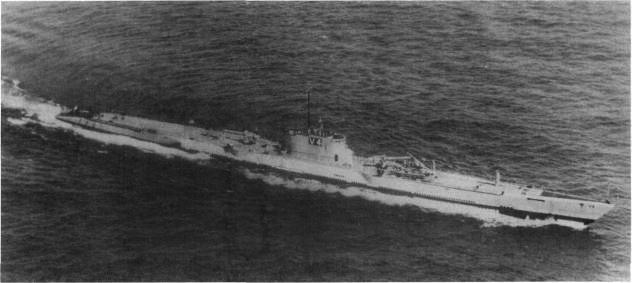
USS Argonaut was ordered and laid down at Portsmouth Naval Shipyard, Kittery, Maine on 1 May 1925, launched 10 November 1927 and commissioned on 2 April 1928, four years in construction, which was quite long for a submarine but justiiable given her size and complexity. V-4 (this was painted on her conning tower) served with Submarine Division 12 (SubDiv 12) based at Newport in Rhode Island, so on the Atlantic Coast. Sea trials showed how much she was underpowered, with her MAN diesels being were a constant source of troubles, albeit arguably less than V5 and 6. In January–February 1929, V-4 made trials off Provincetown in Massachusetts. During such trial dive she went down to 318 ft (97 m), marking the greatest operational depth the service so far at least in the US. On 26 February 1929, she was reassigned to Submarine Division 20 (SubDiv 20) at San Diego, California, so with the Pacific fleet which had been her originally intended theater. She arrived after her transit via panama on 23 March. She took part in battle exercises, this year fleet problem and cruised along the West Coast.
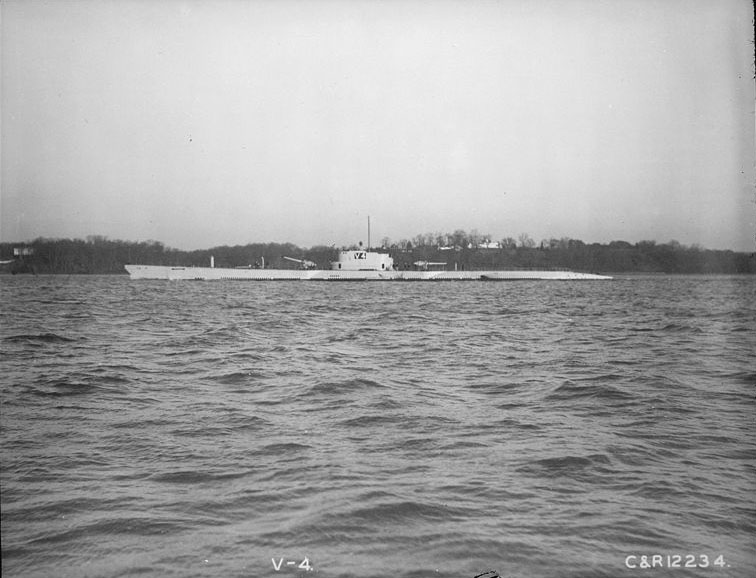
V4 in November 1928, freshly completed on the east coast.
In 1931, V-4 was used for the filming of “Seas Beneath” an action movie by John Ford, repainted as the WWI German submarine “U-172”.
She was officially renamed “Argonaut” on 19 February 1931 like her other V sisters, redesignated SM-1 (as submarine, minelayer) on 1 July in the new US ordnance nomenclature. She remained unique in the latter. On 30 June 1932, she was homeported to Pearl Harbor with SubDiv 7. Not only she proceeded to minelaying operations, both for training and defend accesses to Pearl Harbour and spet time in long patrol duty. In October 1934 and May 1939, she took part in joint Army-Navy exercises over Hawaii. She became flagship of SubRon 4 as well due to her large size usable as command ships. She was back on the West Coast by April 1941 to participate in fleet exercises.
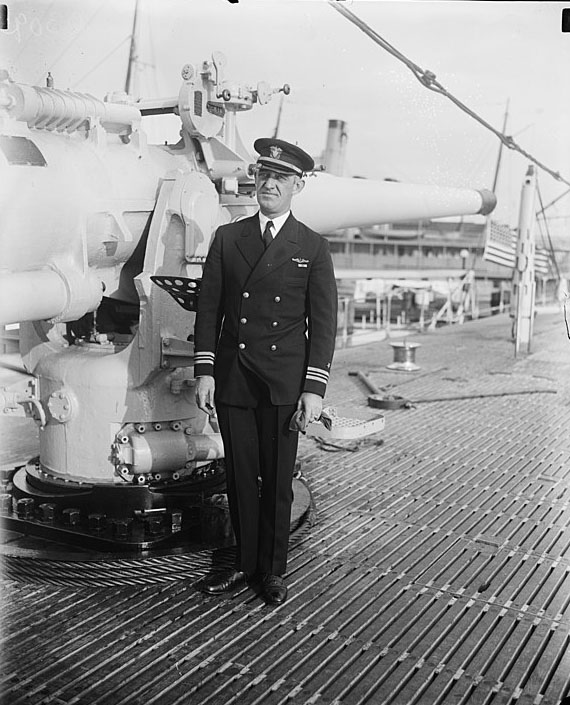
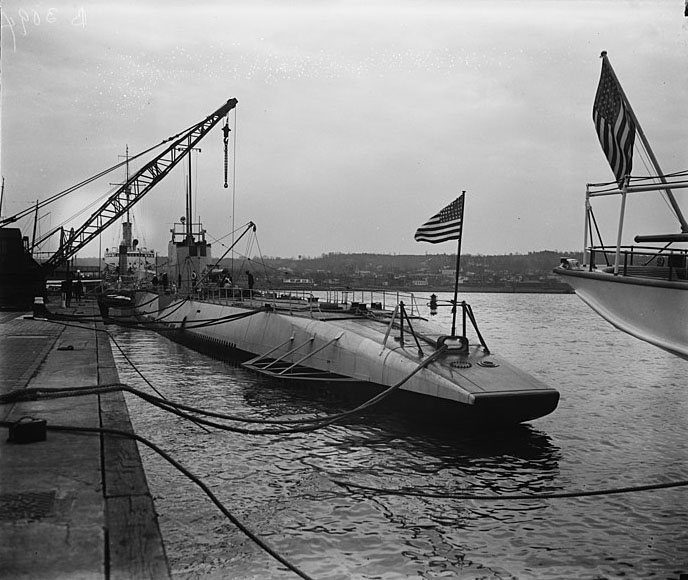
V4 in visit to Washington DC, with Lt.Cdr. Quigley in command.
USS Argonaut’s WW2 campaign
On 28 November 1941 under Stephen G. Barchet, her first wartime captain, she left Pearl Harbor to patrol around Midway Island, accompanied by with USS Trout. On map they were located as “Midway Defense Group 7.2”. Captain Barchet learned by radio about the Pearl Harbor attacked after surfacing after sunset on 7 December. Two hours later she investigated naval gunfire around Midway and made the first wartime approach on an approaching Japaned force, but her poor maneuverability foiled any attempt to close in a suitable position for surfaced torpedo launch when she saw two Japanese destroyers shelling Midway. One spotted Argonaut as she dived for a submerged second approach in the moonlight and escaped. She was later able to maneuver into position and launch torpedoes but missed. Later she left the night pass submerged and surfaced at dawn to recharge batteries when spotted by a patrol plane from Midway, bombed and missed.
However an “old friend” of submariners, condensation, pointed its ugly head when dehumidifiers failed to prevent it from building up. Electrical fires started to break down many electrical systems, whereas three crewmen in this damp caught high fever so the captain discussed with officers if justifiable to sail back to Pearl. Meanwhile, President Roosevelt mentioned her in a radio speech and this boosted morale, encouraged Barchet stay on patrol. With his crew he trained a trimming procedure in order to rapidly gain 17 tons heavy, and reduced by 52 seconds her diving time, through coordinated pumping on both ballast tanks, yet it was still too slow. Later as food and fuel started to run dry, she sailed back from her first war patorl, meeting the destroyer USS Litchfield at 06:00 20 January 1942, and she was escorted back to Pearl Harbor.
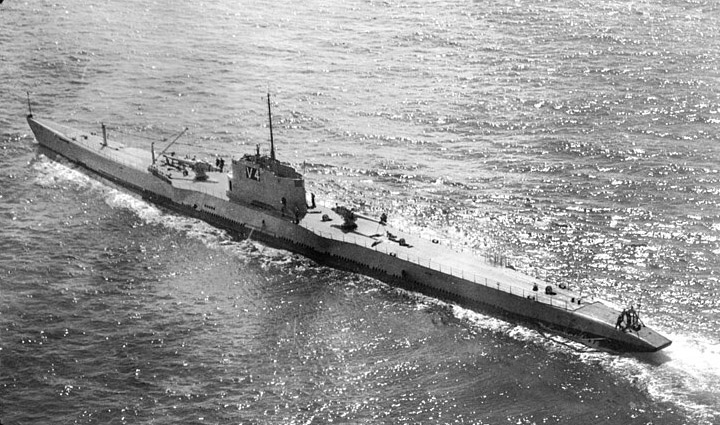
USS Argonaut, interwar, seen from an aircraft, AL-135B from JL Highfill Album Image, CC
There was no doubt that her issues could have been write off USS Argonaut from service, but her immense size, range and capacity were unrivalled in the USN at the time and officers dicussed how she could be of some use in the present combat. As a minelayer she was over-complicated, and back in 1925 aviation was not what it was in 1942. So on 22 January 1942, while in Pearl Harbor she was redirected to sail to Mare Island Naval Shipyard for a major overhaul. Her diesels were replaced as seen above (General Motors Winton 12-258Ss rated for 4,800 hp (3,600 kW)) and she gained hydraulic drive through reduction gears.
Her finnicky minelaying gear was completely removed. The space left was reconverted to be a troop transport submarine, a unique case in US naval history. The auxiliary diesel generator was also sawapped for smaller GM Winton 8-268A and GM Winton 4-268A models and to enhance her combat capabilities, she gained a torpedo Data Computer as well as new electronics, radar, sonar suite, communication gear, and a modified conning tower. She also gained two external stern torpedo tubes on the after casing and two stern deck stowage tubes but on photos she lacked apparently her bow external torpedo tubes. Back to Pearl Harbor, her troop transport conversion was completed
She was, after months of training in April to July 1942 redirected in the South Pacific, sailing in August under ordered of Admiral Chester W. Nimitz together the converted USS Nautilus to transport and land Marine Raiders on Makin Island in the Gilberts. This was aimed at relieving pressure on US forces stranded on Guadalcanal. On 8 August, they sailed with together 120 men of A/B company, 2nd Raider Battalion. Conditions were highly unpleasant during the trip, most marines becoming seasick until they arrived off Makin on 16 August. At 03:30 Marines landed using rubber rafts in rough weather. In fact seawater quickly swamped their outboard creeping motors and had to paddle their way to the shore. But just as they arrived, the Japanese in high alet pointed suddenly their projectors at the sea, and between snipers were hidden in the trees and machien guns nest ready for them, and the landing was stroingly opposed. Bu the Mrine went through anyway. The initial plan was to get behind them but despite the odds, the Raiders managed to hit all their objectiives. On 18 August the 85 garrison men had ben killed or captured, and the radio stations as well as the fuel and supplies were all dynamited. The Marine raiders lost 30 men in the assault, mostly in the shore approach. There were many wounded as well. But the mission was a success.
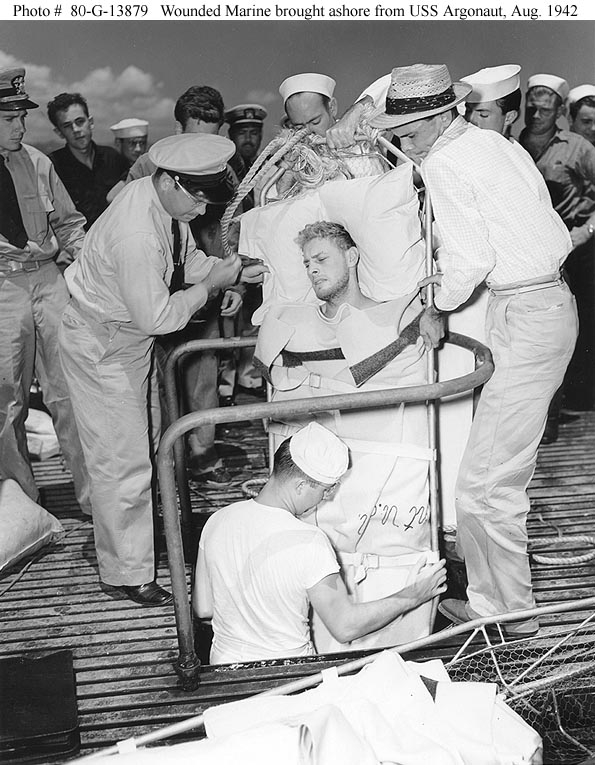
A Marine Raider, injured during the Makin operation, is lifted through a hatch on USS Argonaut to be taken ashore at Pearl Harbor, 26 August 1942.
USS Argonaut was back to Pearl Harbor on 26 August and her designation became APS-1 (transport submarine) on 22 September. The bogus number “SS-166” sometimes painted on her CT was only there to confuse IJN intel, albeit in ordnance, this number was reserved for her indeed. She was homeported to Brisbane, Queensland, to assist this time forces in New Guinea and the Solomons again. In December, she departed Brisbane under command of her last captain, Lieutenant Commander John R. Pierce. She was designed a patrol area between New Britain and Bougainvilleand south of the Bismarck Archipelago. This was dense with Japanese traffic.
On 2 January 1943, she spotted and sank the auxiliary Japanese gunboat Ebon Maru in the Bismarck Sea. On 10 January, she spotted a convoy of five freighters escorted by the destroyers Maikaze, Isokaze, and Hamakaze transiting from lae to Rabaul. US Aregonaut prepared to attack, placed into a launching position and started her attack when witnessed by a USAAF aircraft out of bombs flying overhead. She apparently made a single hit on a destroyer when they spotted her and counterattacked. The aircraft saw later her bow suddenly breking water after perhaps a depth charge hit her. Destroyers shelled her until she sank for good with her whole 102 men crew. This was the single worst loss of life for any WW2 American submarine. The aircraft reported her loss and she was stricken on 26 February. The Japanese reported she was depht-charged and forced to surface and then indeed they “destroyed the top of the sub” by gunfire.
Captain Pierce was credited of damaging a Japanese destroyer but it’s still controversial today.
Her donated bell before the last patrol is the only left relic of the largest US sub for decades. The Submarine Memorial Chapel was built, dedicated on the Submarine Base in Pearl Harbor and housed the bell ever since, ringing for services.
Read More/Src
Books
Schlesman, Bruce and Roberts, Stephen S., “Register of Ships of the U.S. Navy, 1775–1990: Major Combatants” Greenwood Press, 1991
Lenton, H. T. American Submarines (Navies of the Second World War) Doubleday, 1973
Silverstone, Paul H., U.S. Warships of World War II (Ian Allan, 1965)
Campbell, John Naval Weapons of World War Two (Naval Institute Press, 1985)
Whitman, Edward C. “The Navy’s Variegated V-Class: Out of One, Many?” Undersea Warfare, Fall 2003, Issue 20
Gardiner, Robert and Chesneau, Roger, Conway’s All the World’s Fighting Ships 1922–1946, Conway Maritime Press, 1980.
Friedman, Norman “US Submarines through 1945: An Illustrated Design History”, Naval Institute Press, Annapolis 1995
Johnston, David “No More Heads or Tails: The Adoption of Welding in U.S. Navy Submarines”, The Submarine Review, June 2020
Conway’s all the world’s fighting ships 1921-47, page 142.
Links
web.archive.org fleetsubmarine.com
uboat.net/ type U142
oneternalpatrol.com /uss-argonaut-
en.wikipedia.org/ USS_Argonaut_(SM-1)
navsource.org/
navweaps.com 6in/53 mk12 gun
navweaps.com/ PreWWII us torpedoes
pigboats.com Submarine_Classes
Videos
Model Kits
https://www.scalemates.com/kits/blue-ridge-models-brm-35033-uss-argonaut-v4-sm-1–1304835

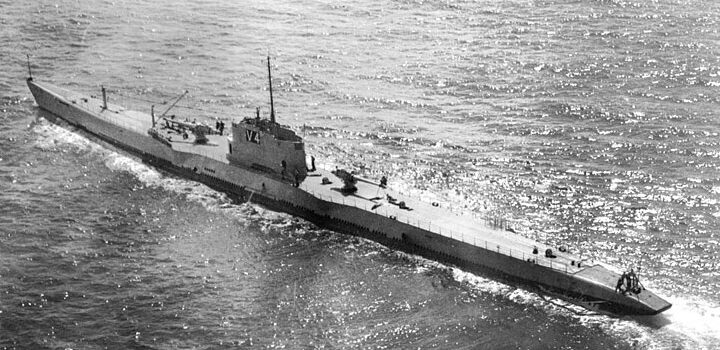
 Cruiser submarine (1925-1943)
Cruiser submarine (1925-1943)


 Latest Facebook Entry -
Latest Facebook Entry -  X(Tweeter) Naval Encyclopedia's deck archive
X(Tweeter) Naval Encyclopedia's deck archive Instagram (@navalencyc)
Instagram (@navalencyc)





 French Navy
French Navy Royal Navy
Royal Navy Russian Navy
Russian Navy Armada Espanola
Armada Espanola Austrian Navy
Austrian Navy K.u.K. Kriegsmarine
K.u.K. Kriegsmarine Dansk Marine
Dansk Marine Nautiko Hellenon
Nautiko Hellenon Koninklije Marine 1870
Koninklije Marine 1870 Marinha do Brasil
Marinha do Brasil Osmanlı Donanması
Osmanlı Donanması Marina Do Peru
Marina Do Peru Marinha do Portugal
Marinha do Portugal Regia Marina 1870
Regia Marina 1870 Nihhon Kaigun 1870
Nihhon Kaigun 1870 Preußische Marine 1870
Preußische Marine 1870 Russkiy Flot 1870
Russkiy Flot 1870 Svenska marinen
Svenska marinen Søværnet
Søværnet Union Navy
Union Navy Confederate Navy
Confederate Navy Armada de Argentina
Armada de Argentina Imperial Chinese Navy
Imperial Chinese Navy Marinha do Portugal
Marinha do Portugal Mexico
Mexico Kaiserliche Marine
Kaiserliche Marine 1898 US Navy
1898 US Navy Sovietskiy Flot
Sovietskiy Flot Royal Canadian Navy
Royal Canadian Navy Royal Australian Navy
Royal Australian Navy RNZN Fleet
RNZN Fleet Chinese Navy 1937
Chinese Navy 1937 Kriegsmarine
Kriegsmarine Chilean Navy
Chilean Navy Danish Navy
Danish Navy Finnish Navy
Finnish Navy Hellenic Navy
Hellenic Navy Polish Navy
Polish Navy Romanian Navy
Romanian Navy Turkish Navy
Turkish Navy Royal Yugoslav Navy
Royal Yugoslav Navy Royal Thai Navy
Royal Thai Navy Minor Navies
Minor Navies Albania
Albania Austria
Austria Belgium
Belgium Columbia
Columbia Costa Rica
Costa Rica Cuba
Cuba Czechoslovakia
Czechoslovakia Dominican Republic
Dominican Republic Haiti
Haiti Hungary
Hungary Honduras
Honduras Estonia
Estonia Iceland
Iceland Eire
Eire Equador
Equador Iran
Iran Iraq
Iraq Latvia
Latvia Liberia
Liberia Lithuania
Lithuania Mandchukuo
Mandchukuo Morocco
Morocco Nicaragua
Nicaragua Persia
Persia San Salvador
San Salvador Sarawak
Sarawak Uruguay
Uruguay Venezuela
Venezuela Zanzibar
Zanzibar Warsaw Pact Navies
Warsaw Pact Navies Bulgaria
Bulgaria Hungary
Hungary

 Bundesmarine
Bundesmarine Dutch Navy
Dutch Navy Hellenic Navy
Hellenic Navy Marina Militare
Marina Militare Yugoslav Navy
Yugoslav Navy Chinese Navy
Chinese Navy Indian Navy
Indian Navy Indonesian Navy
Indonesian Navy JMSDF
JMSDF North Korean Navy
North Korean Navy Pakistani Navy
Pakistani Navy Philippines Navy
Philippines Navy ROKN
ROKN Rep. of Singapore Navy
Rep. of Singapore Navy Taiwanese Navy
Taiwanese Navy IDF Navy
IDF Navy Saudi Navy
Saudi Navy Royal New Zealand Navy
Royal New Zealand Navy Egyptian Navy
Egyptian Navy South African Navy
South African Navy






























 Ukrainian Navy
Ukrainian Navy dbodesign
dbodesign